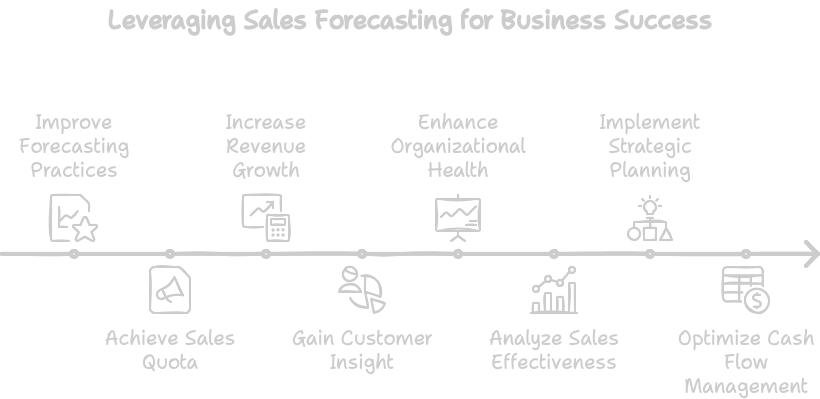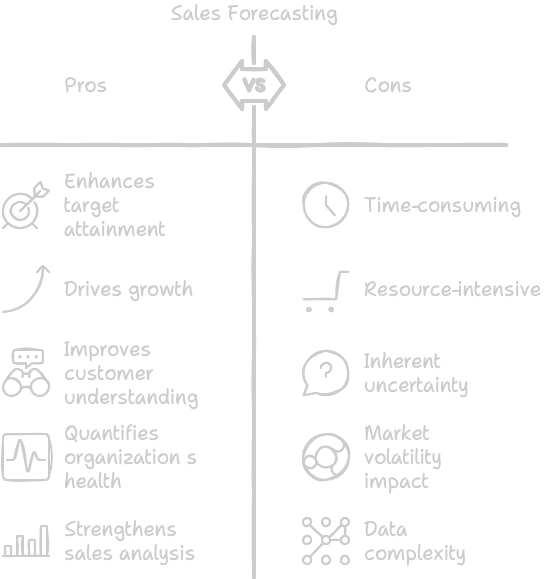The Big Wins: Understanding “Strategic Forecasting Advantages”
Are you interested in gaining a competitive edge in your business or organization? Understanding the strategic forecasting advantages can help you make informed decisions and stay ahead of the game. By analyzing trends and predicting future outcomes, you can anticipate market changes, identify opportunities, and mitigate risks. This article will explore the big wins of strategic forecasting and how it can benefit your long-term success.
Whether you’re a business owner, manager, or aspiring entrepreneur, strategic forecasting can give you the insights you need to thrive in a dynamic and ever-changing marketplace.

Big Benefits of Guessing What’s Next in Business
See Into the Future: What Guessing Can Show You
Sales Forecasting: The Advantages of Anticipating Demand
Forecasting demand for sales can offer great advantages to companies. Predicting and preparing for demand fluctuations is vital in today’s competitive business arena. But what can guessing at future sales actually show you? Let’s explore.
One advantage is gaining valuable insight. By analyzing past and real-time data to predict future demand, you can anticipate fluctuations more effectively and gain insight into your company’s overall health. This insight can help you make necessary adjustments and course corrections.
Another advantage is learning from past mistakes. Each forecast provides a starting point for evaluating why predictions may have been inaccurate. Reflecting on past performance leads to improved forecasts and overall business growth.
Additionally, forecasting can decrease costs. Accurate demand anticipation can enhance supply chain efficiency and reduce excess inventory, ultimately increasing profitability.
While forecasting has disadvantages, the benefits of gaining insight, learning from mistakes, and reducing costs outweigh the challenges. Embracing sales forecasting as a tool for making informed decisions can give your company a competitive edge, ultimately leading to sustained success.
Learn and Get Better: How Past Goofs Help Us
Presenting the Fox’s Guide to Learning from Past Mistakes
Learning from our past mistakes is integral to strategic forecasting and can help businesses gain a competitive advantage. By analyzing past forecasting errors, companies can refine their processes and develop more accurate predictions for the future. Take, for example, a company that experienced a significant overestimation of product demand, leading to excessive inventory levels. By reflecting on this mistake, the company adjusted its forecasting methods, leading to more efficient inventory management and decreased costs.
Another practical example can be seen in the retail industry, where businesses often struggle with accurately predicting consumer purchasing behavior. Companies that leverage past sales data to learn from forecasting errors can better anticipate shifts in consumer preferences and adjust their marketing strategies accordingly.
Spend Less Money: Ways Smart Guesses Cut Costs
Smart Strategies for Cost Savings through Effective Forecasting
Forecasting is a valuable tool for businesses. It provides insight into future demand, allows for learning from past mistakes, and ultimately decreases costs. By anticipating demand and predicting customer needs, companies can strategically adjust their processes to increase efficiency along the supply chain. This may lead to reducing excess inventory levels, ultimately increasing overall profitability.
For example, if a company forecasts an increase in demand for a particular product, it can adjust its production levels accordingly, avoiding unnecessary or excess production costs. Additionally, forecasting can help companies identify trends in customer behavior, allowing them to tailor their marketing and advertising efforts more effectively and save costs on ineffective campaigns.
Furthermore, by learning from past forecasting errors, companies can improve their processes over time, reducing costly mistakes and ensuring a more accurate prediction of future demand. This will allow for more efficient resource allocation and inventory management, ultimately leading to significant cost savings for the company.
Tough Parts of Trying to Predict Business Things
They’re Not Always Right: The Truth About Business Guesses
The Truth About Forecasting Practices
Business guesses, also known as forecasting, are fundamental to strategic business operations. While forecasting provides several advantages, it’s essential to acknowledge that it’s not always foolproof.
By analyzing past and real-time data, forecasting allows companies to gain valuable insights into future demand and make necessary adjustments. For instance, it can help in predicting demand fluctuations, thus improving overall efficiency.
On the contrary, forecasts are never 100% accurate and can be time-consuming and expensive. Despite these disadvantages, forecasting processes can be massively beneficial if done right.
For example, forecasting aids in target attainment, propelling growth, and quantifying an organization’s health. It also enables continuous strategic planning and streamlines cash flow and financing.
While the disadvantages of forecasting should not be ignored, the benefits are abundant. Accurate data, combined with internal and external sources, can position businesses to thrive in changing market conditions, making forecasting essential for sustained success in the business world.
It Takes Time and Stuff: Why Guessing Is Hard Work
Sales Forecasting: A Challenging Yet Essential Practice
Predicting future sales is a challenging task that requires careful consideration and analysis. While it may not be easy, it offers numerous advantages for companies. In today’s competitive business environment, any advantage over the competition is positive. However, some disadvantages should be weighed when considering which forecasting process is right for your business.
One advantage of forecasting is gaining valuable insight into past and real-time data to predict future demand. This insight allows companies to anticipate demand fluctuations more effectively and make necessary adjustments. Another advantage is learning from past mistakes and reflecting upon past performance. Anticipating demand can also help decrease costs by increasing efficiency along the supply chain.
On the other hand, forecasting also comes with disadvantages. Forecasts are never 100% accurate, and predicting the future is inherently challenging. Additionally, the process can be time-consuming and resource-intensive, requiring substantial input from various teams within the company. It can also be costly, as it often involves hiring a team of demand planners and investing in advanced software and processes.
Despite these disadvantages, forecasting is a valuable business practice providing companies with a competitive edge. By understanding these advantages and disadvantages, companies can make informed decisions about their forecasting practices and improve their overall performance.
How to Use Big Outside Events to Make Better Business Guesses

Winning the Game: Why Good Guesses Keep You Ahead
Sales forecasting is a strategic advantage that can significantly impact a company’s success. By honing in on effective forecasting practices, businesses can gain a competitive edge over their industry peers. Here are the compelling reasons why good guesses keep you ahead:
- Target Attainment: According to The Aberdeen Group, 97 percent of companies with industry-leading forecasting processes reach sales quota, showcasing the pivotal role of accurate forecasting in goal achievement.
- Revenue Growth: Mastering the science of sales forecasting can result in a 10% increase in annual revenue growth and a higher likelihood of outperforming industry competitors.
- Customer Insight: Sales forecasting provides valuable insight into customer behavior, enhancing cross-sell and upsell opportunities that enhance revenue efficiency and customer understanding.
- Organizational Health: Forecasting represents a company’s entire operating rhythm, offering a holistic view of its overall health and performance, as Kevin Knieriem, Chief Revenue Officer at Clari, states.
- Sales Analysis: Accurate forecasts assist sales leadership in evaluating product contributions to the bottom line, sales rep ramp-up times, and manpower requirements.
- Strategic Planning: Continuous forecasting enables organizations to respond more effectively to market dynamics, justify hiring decisions, and allocate resources strategically.
- Cash Flow Management: Effective sales forecasts streamline cash flow, credit, and financing, positioning businesses to predict payments accurately and negotiate better terms for credit and corporate funding.
By leveraging the advantages of sales forecasting, businesses can elevate their revenue operations and achieve sustained success.
Smart Moves for Smart Guesses: Steps to Get It Right

Getting Ready: How to Start Making Good Guesses
Forecasting is a valuable tool that can provide significant advantages to companies in today’s competitive business world. One key benefit of forecasting is gaining valuable insight into past and real-time data, which allows for the prediction of future demand and the anticipation of demand fluctuations more effectively. For example, a company that implements forecasting processes might be able to adjust its inventory levels to meet customer demand more accurately, thus decreasing excess inventory costs and increasing overall profitability.
In addition, forecasting provides an opportunity for companies to learn from past mistakes. By reflecting on previous forecasting performance, companies can improve their forecasting accuracy over time, leading to more informed business decisions and greater efficiency in their processes.
Another valuable advantage of forecasting is its ability to decrease costs by increasing efficiency across the supply chain. For example, by accurately predicting customer demand, a company may streamline its production processes and reduce excess inventory levels, thus saving on costs and maximizing profits.
Oops! What to Do When Your Guesses Aren’t Perfect
Forecasting is a valuable tool for modern businesses, providing insights that can guide decision-making and strategic planning. However, it’s essential to acknowledge that forecasts are not always perfect. When your predictions don’t align with reality, there are steps you can take to realign your forecasting process.
For example, when your forecasts miss the mark, it’s an opportunity to learn from mistakes. By analyzing where and why your predictions went awry, you can refine your forecasting methods for the future. Additionally, while forecasting can be time-consuming and resource-intensive, investing in the right technology and talent can mitigate these challenges.
Moreover, it’s crucial to understand that forecasts are inherently uncertain. Factors such as market volatility and data complexity can impact the accuracy of predictions. However, by integrating external event data and balancing internal and external data sources, businesses can enhance the accuracy of their forecasts and improve adaptability in changing market conditions.
Changing It Up: Fixing Your Guessing Game Plan
Seven Benefits of Superior Sales Forecasting
- Enhances target attainment: Companies with industry-leading forecasting processes are 97% more likely to meet sales quotas than 55% of organizations that don’t implement best-in-class approaches.
- Drives growth: Teams mastering sales forecasting are 10% more likely to grow annual revenue and twice as likely to outcompete their industry peers.
- Improves customer understanding: Effective forecasting provides insight into customer behavior, contributing to efficient cross-sell and upsell strategies.
- Quantifies organization’s health: A sales forecast represents the entire operating rhythm of the entire company, including sales, marketing, and customer success.
- Strengthens sales analysis: Accurate forecasts assist sales leadership in analyzing product contributions to the bottom line, sales rep ramp-up time, and hiring decisions.
- Enables strategic planning: Continuous forecasting allows organizations to respond with less failure to the changing market pace, leading to better resource allocation and risk management.
- Streamlines financial processes: Effective sales forecasts position companies to accurately deliver and predict payments and obtain better terms when seeking credit and corporate financing.
These benefits highlight the importance of a solid sales forecasting process, providing a compelling case for businesses to invest in accurate forecasting methods.

Vizologi is a revolutionary AI-generated business strategy tool that offers its users access to advanced features to create and refine start-up ideas quickly.
It generates limitless business ideas, gains insights on markets and competitors, and automates business plan creation.


